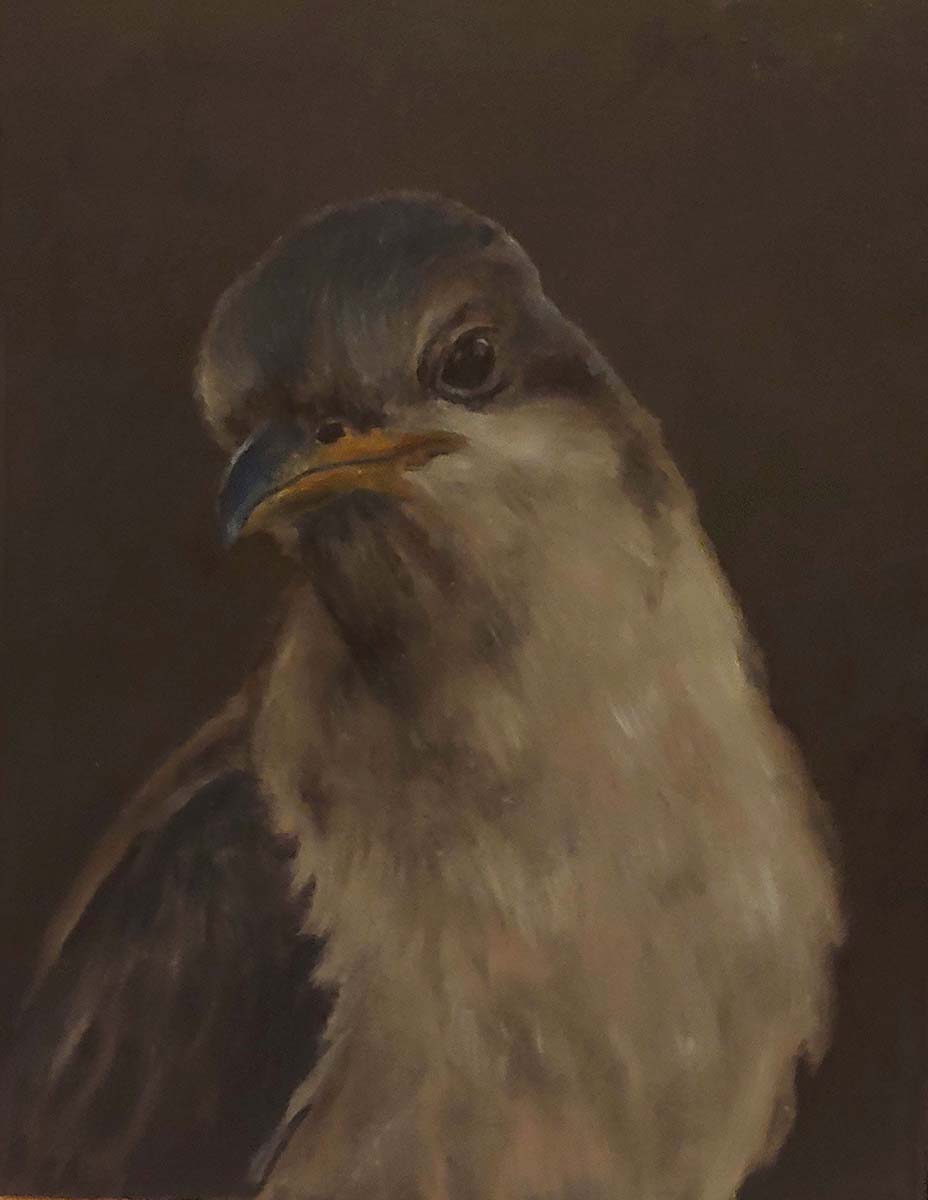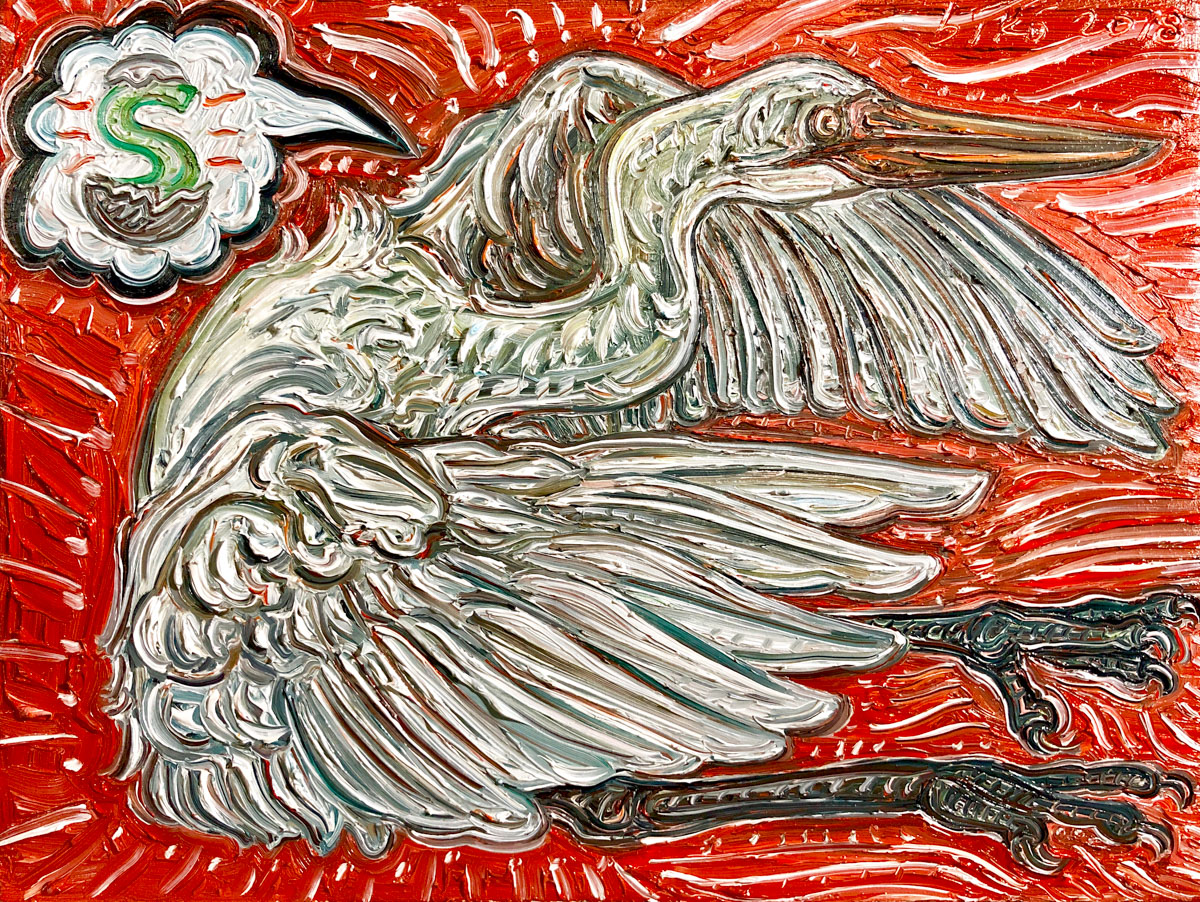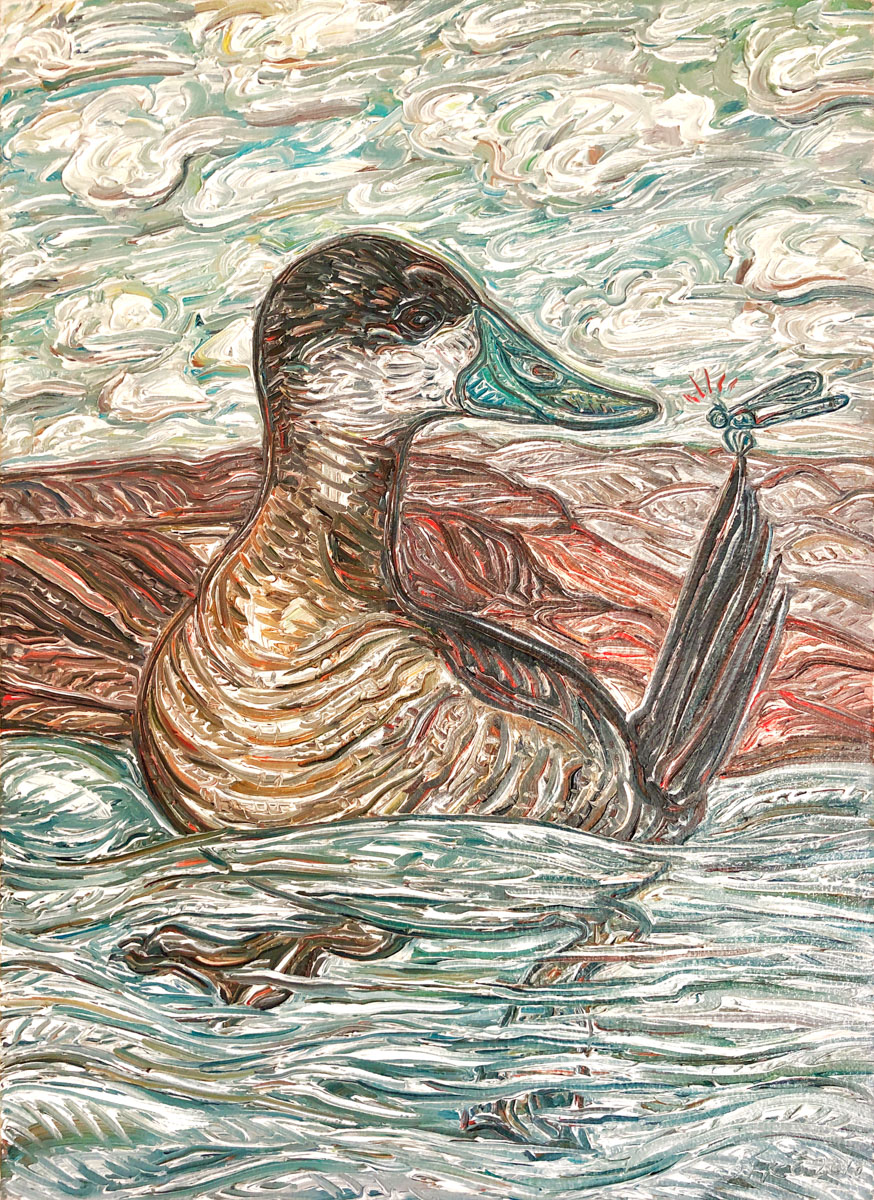Birds of NV: Gig Depio and Darren Johnson
Gig Depio, Yowza!, oil on canvas, 2018. Photo Gig Depio.
D.K. Sole reviews the exhibition “Birds of NV: Gig Depio and Darren Johnson,” currently on view at Priscilla Fowler Fine Art in downtown Las Vegas.
As the Gallery Services Coordinator of the Las Vegas-Clark County Library District, Darren Johnson has put dozens of exhibitions in front of us. His job, from our perspective, is to show us other people’s work. What does he make when he is creating art himself? Whether that should be one of your guiding questions as you approach this show or not I can’t say, but I’m intrigued by it at least, since the last time I saw his paintings he was teasing at the idea of communication between people by representing it with speech bubbles. Here, back from an artmaking hiatus, he sees birds perching on branches or sitting in their nests, essentially still. Sometimes they are busts with no legs. Maybe they turn their heads to examine you, making you aware of the alien side-of-skull perspective the real animals stare from, maybe they are wary; in several paintings they have their eyes shut and the titles suggest they are asleep. These titles – Dreamer, Huddled Mass, Concert of the Birds–State Song Snore – ask you to turn your attention to the DREAM Act, the rights of migrants, and political inertia. Whatever ideas you already have about those things bubble up inside your head. Maybe all that sleepiness points you to a popular tagline. Get woke, you mutter. How does the image convert this idea? Now you pause. What is the DREAMer bird doing?
Darren Johnson, Concert of Birds - State Song Snore, oil on canvas, 2018. Photo Darren Johnson.
What strikes me is its opacity. When I see it closed-in, eyes shut, cupped in a fork, I want to say, “It is being itself.” What is “itself”? The image neither asks that question nor answers it. The absence of actual speech from Johnson’s speech-bubble pictures suggested a paradoxical muting, and these new paintings ring with silence too. If there is envy present in Monomania of eNVy, 2018, his portrait of a yellow-billed cuckoo, then what form does it take? The cuckoo itself stares sideways at you, its eye in the place of your ear. A note in a supplementary document refers me to Gericault’s L’Monomane de l’envie, 1822. A mountain bluebird prepares to step into a void.
Gig Depio’s birds, unlike Johnson’s, are active without hesitation, leaping, flying, twisting, folding themselves into the frame like a paperclip; paddling their feet in a nest of eggs marked with dollar signs as they stretch at a branch of fruit; flitting away from the open bill of a hungry great white egret (the sinewy throat is so intense that you worry for the straining chick, a wood duckling); or flying by a field of text and photo – a magazine cover -- where you can make out the names of Robert Mapplethorpe and (partly) Richard Prince, along with the words “Art and design,” a beaming pile-of-shit emoji, and a mutter of headlines: “David Blaine / Posturing / How the art market really works.” Criticism, conference, argument, play a key role in Depio’s oeuvre. Even his brushstrokes whip and press against one another. In him, representations of speech work with the pictures to create metaphors, finding a route around Johnson’s impasse of silence. Not separation but unity. A hamburger icon near the wood duckling is surmounted by the word YOWZA!, underlining the little bird’s possible future (fast food, yay!) at the same time that it projects us into the egret. If the duckling is a hamburger then we, collectively, being human, are the eater, and a conduit has been opened to allow for further thought. OK. Now what about the concrete structures we can see behind the birds? Hoover Dam? The duckling is distracted by a green $-shaped worm. Food is not the only thing we’re gobbling up then. Food is something else as well.
Gig Depio, All-American Breakfast, oil on panel, 2016. Photo Gig Depio
You recall his other birds. There was the hooded goose uttering a snake-worm out of a green egg over dollar-armpits Jeff Koons in that big canvas, Not So Koi, 2016. You saw itin the Skull exhibition over at the West Sahara Library. Eggs in several of his Birds of NV paintings are also associated with money. Are they a play on words, “a nest egg” embodied? Is it the way that eggs hatch, producing potent surprises, hinting that money is never a sure thing, that possession always carries some implication of luck? The egg under that flapping chicken in the magazine-cover painting -- All-American Breakfast, 2016 -- is cooking in a pan while the bird itself imagines a perfect baby icon popping out of a shell. Can the strutting text at the top, with its celebration of art as spectacle, be imagined as some equivalent of that plasticky sureness? Where is the reality? Who deserves to be represented on the cover of a magazine? What does it mean to deserve such things anyway? Depio’s forceful presentation asks us to imagine a set of ideas so firmly held that the birds themselves can be understood as both real and nonconcrete, like figures in Dante. We accept them when they are in the solid-looking landscape of a painting like Ruddy Ate his Buddy, 2018, and also when they occupy the spaces of thought. The round eye of the great white egret is no more humanly expressive than the face of Monomania’s cuckoo, but in Depio the notion of a mental distance between yourself and the bird is simultaneously upheld and crossed.
Darren Johnson, Brown-headed Cowbird after Gilbert Stuart, oil on panel, 2019. Photo Darren Johnson.
If Depio zooms past hesitation, gouging a wing-line into the paint and knifing diagonal rails off the bottom, then Johnson looks around for the falter of that ignored gap. The Gilbert Stuart painting he is thinking of in Brown-headed Cowbird after Gilbert Stuart, 2019, is not one of the portraitist’s finished works but the incomplete George Washington head of 1796. Look, half the canvas is still waiting to be covered. Working on copper in Yellow Warbler Nest, 2019, he exposes a section of the metal marked with circular scratches. The thin spiralling scrape doesn’t really relate to the snug figure of the bird in its nest: two separate fields of action are sliding past one another without speaking. More brown-headed cowbirds – including Dreamer and Huddled Mass and a third one called Manifest Destiny – are mirrored by other works named Shadow. Scratched into black paint, the Shadow cowbirds are the unfilled linework versions of their other selves. The same notes that pointed me to Gericault explain the parasitic nature of the brown-headed cowbird, a sneak that replaces other birds’ eggs with its own so that each cowbird is haunted by an unborn phantom of another species.
How this relates to the political critique in the titles I haven’t sorted out for myself yet. The idea of a thing that should be there, completed, but isn’t, keeps returning to Johnson, in a way that isn’t fully brushed off by the show’s blurb, which asks you to consider “the migratory nature of many of these birds and their ability to freely traverse across the imagined boundary lines established by our governments” in light of “the recently-debated topic of immigration.” Depio’s part of the show, with its paintings split between 2016 and 2018, takes stock of the shift between his Koi-related thoughts and the more recent frame of mind that belongs to the naturalistic mural he unveiled at the the Moapa Valley Community Center in Overton last December. “Great [white] egrets range widely over the continent,” notes the Cornell Lab of Ornithology. The joke of the title is that these are not the birds of Nevada – they’re the birds of everywhere.
Images left to right: Darren Johnson, Monomania of eNVy (yellow-billed cuckoo), oil on panel, 2018; Darren Johnson, Huddled Mass, oil on panel, 2019. Gig Depio, Great White Egg-ret, oil on panel, 2018; Gig Depio, Ruddy Ate His Buddy, oil on canvas, 2018. Photos courtesy the artists.
“Birds of NV: Gig Depio and Darren Johnson” is on view at Priscilla Fowler Fine Art through March 30th, 2019
Australian artist D.K. Sole lives in Las Vegas, Nevada, and works at the UNLV Marjorie Barrick Museum of Art where she is in charge of Research and Educational Engagement. She has exhibited in Las Vegas and Denver, Colorado.








